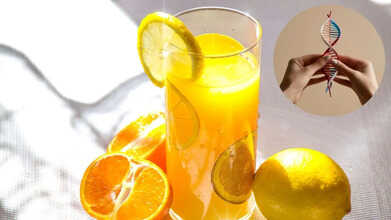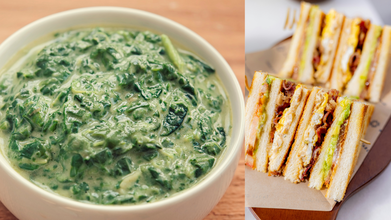- Health Conditions A-Z
- Health & Wellness
- Nutrition
- Fitness
- Health News
- Ayurveda
- Videos
- Medicine A-Z
- Parenting
Chemicals Found In Sugar-free Desserts May Impair Brain Function, Study Finds

Credit: Canva
A common sugar substitute found in "sugar-free" drinks and desserts may be impairing your brain function. A new study presented at the American Physiology Summit indicated that erythritol, found in many desserts and drinks, may impair blood vessel health by disrupting the brain's production of nitric oxide. Cells exposed to typical erythritol levels showed increased oxidative stress and reduced nitric oxide, potentially impairing blood flow.
It is pertinent to know that the human brain uses Nitric Oxide as a neurotransmitter that helps regulate blood flow as well as influences neuronal development. The new study explains earlier research linking erythritol to stroke and heart attacks.
How Was The New Study Performed?
In a new study, researchers treated human cerebral microvascular endothelial cells—cells from the tiny blood vessels in the brain—with erythritol. They found that the cells exposed to the amount of sweetener in one beverage serving had higher levels of oxidative (cellular) stress. These cells also produced less nitric oxide, a compound that helps blood vessels dilate. Reduced nitric oxide levels can impair vasodilation, impair blood flow, and may increase the risk of heart attack and stroke.
"While erythritol is widely used in sugar-free products marketed as healthier alternatives, more research is needed to fully understand its impact on vascular health," said Auburn Berry, a graduate student at the University of Colorado Boulder and first author of the study. "In general, people should be conscious of the amount of erythritol they are consuming daily," added.
Here Are Products That Have Erythritol
Erythritol is a low-calorie sugar substitute found in many sugar-free products, including energy drinks, snack foods and protein bars. Like other sugar alcohols, erythritol is popular because it does not affect blood glucose and insulin levels as much as sugar. Here is a list of products that may use this compound as one of its ingredients.
1. Sugar-Free or Keto Snacks
Keto-friendly protein bars (e.g., Quest, Perfect Keto)
Low-carb cookies and brownies (e.g., Lenny & Larry’s Keto Cookies)
Keto peanut butter cups and chocolates (e.g., Lily's, ChocZero)
2. Beverages
Flavored water (e.g., VitaminWater Zero, Bai Antioxidant Drinks)
Zero-calorie energy drinks (e.g., Monster Ultra, Zevia)
Sugar-free iced teas and lemonades
3. Gum and Mints
Sugar-free chewing gum (e.g., Trident, Orbit)
Breath mints (e.g., Altoids Smalls Sugar-Free, Ice Breakers)
4. Sugar-Free Candy and Chocolates
Gummy bears, licorice, or hard candies labeled “sugar-free”
Brands: SmartSweets, Russell Stover Sugar-Free
5. Baking Products
Erythritol sweeteners (e.g., Swerve, Lakanto, PureVia)
Baking mixes like low-carb pancake or brownie mixes
6. Ice Cream and Frozen Desserts
Brands like Rebel, Enlightened, and Halo Top Keto series use erythritol as a sweetener
7. Meal Replacements and Protein Powders
Many low-carb shakes or protein powders include erythritol to keep sugar content low
8. Yogurt and Dairy Alternatives
Low-sugar Greek yogurts or keto-friendly yogurt alternatives.
Your Morning Orange Juice Might Be Shaping Thousands Of Immune Genes At Once

Credits: Canva
While orange juice is a simple part of breakfast for most people, new research shows that this everyday drink may influence the body far more than we once thought. A recent study reports that drinking orange juice regularly can alter how thousands of genes in our immune cells behave. Many of these genes play roles in controlling blood pressure, easing inflammation and managing the way our bodies handle sugar. These are key functions that support long term heart health.
Orange Juice Immune Cell: Orange Juice Found To Affect Genes In Immune Cells
For anyone thinking about staying healthy as they grow older, new findings suggest that one daily glass of a particular drink may lower the risk of several problems. A recent study indicates that a daily serving of orange juice can even reprogramme certain genes. David C. Gaze, Senior Lecturer in Chemical Pathology at the University of Westminster, wrote in The Conversation about the changes that take place inside the body after regular orange juice consumption, drawing on evidence from earlier studies.
Orange Juice Immune Cell: Decline In Genes Associated With Inflammation And Blood Pressure
In the study, adults drank 500 ml of pure pasteurised orange juice each day for two months. After sixty days, genes linked to inflammation such as NAMPT, IL6, IL1B and NLRP3, which tend to switch on during stress, were found to be less active. The SGK1 gene, involved in how the kidneys hold on to sodium, also showed reduced activity. These results fit with older research showing that regular orange juice intake can bring down blood pressure in young adults.
Also Read: Winter Vomiting Disease: Norovirus Cases Rise Across The US—Everything You Should Know
The researchers believe these findings show that orange juice creates small yet meaningful adjustments in the body’s control systems, encouraging blood vessels to relax, lowering inflammation and supporting heart health.
The flavonoid hesperidin in oranges is known for its antioxidant and anti inflammatory effects. The new research adds to this by showing that processes related to blood pressure, cholesterol balance and sugar handling are also influenced by this natural compound.
Body composition appears to shape the response too. Genes connected to fat metabolism changed more in people who were overweight, while inflammation related genes shifted more in leaner volunteers.
Orange Juice Immune Cell: May Reduce Insulin Resistance And Cholesterol
A review of fifteen controlled studies involving 639 people found that regular orange juice intake may lower insulin resistance and LDL cholesterol. Insulin resistance is a major warning sign for pre diabetes, while raised cholesterol increases the chance of heart disease.
In another study with overweight participants, several weeks of daily orange juice slightly lowered systolic blood pressure and raised HDL, the type of cholesterol considered beneficial. These shifts may appear small, yet their effect on cardiovascular health can build over time.
In people with metabolic syndrome, orange juice was shown to improve endothelial function, which refers to the ability of blood vessels to widen and relax. Better endothelial function is tied to a lower chance of heart attack.
Although not every study reported major changes in HDL or triglycerides, the overall pattern suggests that orange juice helps reduce inflammation, supports smoother blood flow and improves key markers linked to heart disease.
Spinach Dip, Paneer Tikka Sandwich, And 5 More 'Pseudo Health Foods' That Are Fooling People, According To Expert

Credits: Canva
Fitness and nutrition coach Raj Ganpath, who has spent nearly two decades helping people rethink how they eat, posted a blunt reminder on Instagram. He called out the growing trend of dressing up regular comfort foods as “healthy” and urged people to stop falling for labels that sound nutritious but mean very little in reality. His message was simple: Eat foods because you enjoy them, not because they are disguised as something they are not.
Pseudo Healthy Food: A Paneer Sandwich, Spinach Dip, And More
Raj began with some of the most common examples. Many people assume that if a dish contains paneer or spinach, it instantly becomes a health food. He pointed out that a paneer tikka sandwich is still just a sandwich with a few pieces of paneer inside. It is not a protein-rich meal and should not be treated like one. He says that one should eat the sandwich because they enjoy the taste, not because they believe it will help them meet their protein goals.
The same goes for the popular spinach dip. Raj reminded people that most spinach dips are rich, creamy and heavy, with only a tiny amount of spinach mixed in. It is not the same as actually eating your greens. If you enjoy it, that is reason enough to have it. However, it is not the nutritional powerhouse many believe it to be.
A Vegetable Pulao Is Still A Rice Dish
Raj then shifted to dishes that people often assume count as a good serving of vegetables. One of these is the humble vegetable pulao. According to him, the few pieces of vegetables in a pulao cannot replace a fresh, full portion of veggies on your plate. In fact, vegetable pulao is still a dish of rice, which is heavy on carbs.
The idea that banana bread or gobi (cauliflower) paratha can double up as fruit or vegetable intake is equally misleading, he points out. Banana bread is a sweet bread. Gobi paratha is a stuffed paratha. They are both delicious but should be enjoyed for what they truly are. Not as healthy alternatives.
The Truth About Sweets Marketed as Better Choices
Raj also addressed common misconceptions around Indian sweets. People often believe that carrot halwa is healthier because it contains carrots. However, the dish is mostly made of milk, sugar and ghee, with carrots playing only a small part. The same goes for dry fruit laddus. They may be sweetened with dates and dried fruits, but that does not make them low calorie or a replacement for whole fruits.
His takeaway was honest. Enjoy these sweets if you like them, but do not convince yourself that they are guilt free or inherently healthy.
A More Honest Way to Approach Food
Raj wrapped up his message with a reminder that truly healthy foods are usually straightforward. Vegetables are for health. Protein rich foods support strength. Starchy foods bring comfort. Desserts bring joy. According to him, the biggest shortcut to health is to stop looking for shortcuts altogether and simply focus on what your body actually needs.
Note: Health and Me does not encourage or discourage anyone to start or stop eating certain food items. Before making any change in your diet, please consult your doctor or a registered nutritionist. This is a user-generated content and in no means substitutes medical advice.
Top-Ranked Diets Of 2025 That Gained Widespread Popularity

Credits: Canva
Whether your goal is to care for your heart, manage your weight or follow a steadier eating routine, finding the right diet can play an important role in supporting your overall well-being. The food you choose becomes your body’s fuel, so getting the right mix of nutrients matters. With so many eating plans available today, it can be hard to know which ones stand out.
Listed below are the nine diets that earned the strongest average ratings. However, speak with your doctor before beginning any new eating plan.
Best Diets of 2025, According to Nutrition Experts
In 2025, several diets gained popularity and were the most searched on the internet:
Mediterranean Diet
The Mediterranean diet is rooted in plant foods such as vegetables, fruits, whole grains, legumes, nuts and olive oil, with moderate portions of fish, poultry, eggs and dairy. It recommends keeping red meat and processed foods to a minimum and is often viewed as a long-term lifestyle choice that includes regular activity and shared meals. This way of eating has been linked to many benefits, especially for heart health.
Research shows the MIND (Mediterranean-DASH Intervention for Neurodegenerative Delay) diet slows age-related cognitive decline. Other work suggests that the MIND diet supports better brain function even when typical age-related changes are present, hinting at its role in helping older adults stay mentally resilient. Lesli Bonci, Director of Sports Medicine Nutrition at the University of Pittsburgh Medical Center, points out that some of the foods highlighted in this plan may feel expensive for certain households, though she praises the diet for what it may offer the brain.
DASH Diet
The DASH (Dietary Approaches to Stop Hypertension) diet is an eating pattern created to help reduce blood pressure. It focuses on fruits, vegetables, whole grains, low-fat dairy, lean protein and nuts, while limiting items high in saturated fat, cholesterol and sodium. The plan advises keeping sodium to 2,300 mg per day, or 1,500 mg for a stricter reduction. It also includes potassium, magnesium and calcium, which play a role in blood pressure control.
The DASH diet was built with heart health as its main goal. Its low-sodium approach has been studied widely, and the findings show that the diet can lower blood pressure and reduce “bad” LDL cholesterol. Followers use a chart to estimate their calorie needs, which then guides their daily servings from each food group. Leslie Bonci, a registered dietitian, board-certified specialist in sports nutrition and member of the Forbes Health Advisory Board, notes that the plan is effective for managing blood pressure, though its focus on produce may make it costlier for some people.
Flexitarian Diet
A flexitarian diet is mostly vegetarian but leaves space for occasional servings of meat or fish. The term blends “flexible” and “vegetarian” and encourages plant foods such as fruits, vegetables, legumes and whole grains, with meat limited to a few times each week or less. It offers a relaxed structure and is often chosen for its possible health and environmental advantages, including weight control and lower risk of certain diseases.
For those who hope to follow a plant-led eating pattern without giving up all animal foods, the flexitarian diet can be a comfortable starting point. The International Food Information Council describes it as a “semi-vegetarian, plant-forward diet” that features fruits, vegetables, legumes, dairy and eggs, with smaller or less frequent servings of meat. Early research indicates that this style of eating may support weight control and reduce the risk of heart disease and diabetes.
Pescatarian Diet
A pescatarian diet follows a vegetarian base but includes fish and seafood while avoiding red meat and poultry. It centers on plant-based foods such as fruits, vegetables, grains and legumes, with seafood added for protein and omega-3 fats. Some pescatarians also choose to include eggs and dairy, depending on personal preference.
Another branch of vegetarian eating, the pescatarian diet earned high scores for its simplicity and safety. A 2020 study showed that pescatarians had lower rates of obesity and were less likely to have cardiovascular risk factors such as high BMI, high blood pressure and high cholesterol. “The eating plan is broad and allows for variety, but one must like fish!” says Lesli Bonci, as per Forbes.
MIND Diet
The MIND diet blends key parts of the Mediterranean and DASH approaches, with the goal of supporting long-term brain health and lowering the risk of conditions such as Alzheimer’s. It encourages regular intake of leafy greens, assorted vegetables, berries, nuts, whole grains, fish, poultry, and olive oil, while advising people to cut back on red meat, sugary foods, butter, cheese, and fried dishes. Its foundation rests on simple, plant-focused eating patterns linked with better protection against age-related cognitive decline.
Studies show that this eating pattern can slow the rate at which memory and thinking skills weaken over time. Research also suggests that people who follow the MIND diet often perform better on cognitive tests, even when age-related changes are present in the brain, which points to stronger resilience. Bonci adds that some of the recommended foods may be costly for certain households, though she supports the diet for its strong potential to aid brain health.
© 2024 Bennett, Coleman & Company Limited

